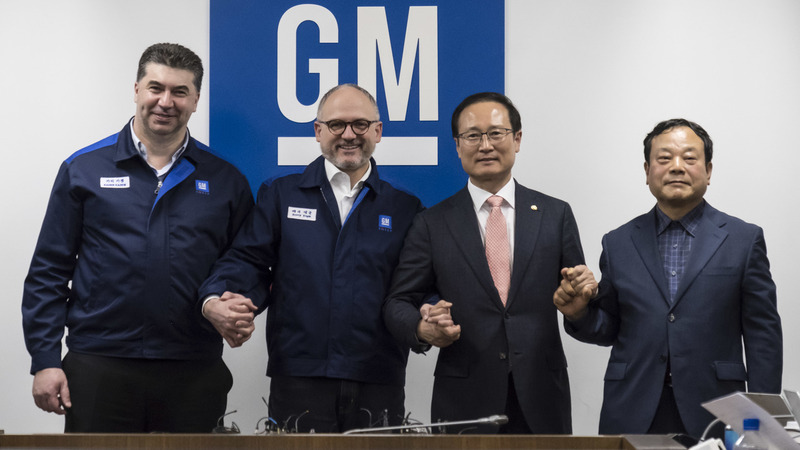 |
|
GM Korea Chief Executive Kaher Kazem (left), GM Executive Vice President Barry Engle, National Assembly member Hong Young-pyo, chair of the Environment and Labor Committee, and Moon Seung, Moon Seung president of Dasung, which represents GM Korea’s subcontractors, hold hands following completion of a labor deal at the company’s Bupyeong plant on Apr. 23. (by Kim Seong-gwang, staff photographer)
|
Agreement marks a turning point in the company’s restructuring efforts
GM Korea labor and management reached a deal on Apr. 23 toward a wage negotiation plan including cost-cutting measures. The two sides announced the tentative agreement on a wage negotiation plan at their 14th round of bargaining talks that afternoon at the company’s Bupyeong factory in Incheon. The agreement means that GM Korea may able to avoid an application for court receivership and find a plan for its recovery. In down-to-the-wire negotiations, the two sides managed to find compromises on key issues including the job security of the 680 remaining Gunsan factory employees who did not apply for voluntary retirement, assignments of new models, and reductions in benefit spending. The union is set to bring the agreement up for a vote by its members on Apr. 25–26. “Through this tentative labor-management agreement, we have set the stage [for GM Korea] to re-emerge as a competitive company,” said GM Korea Chief Executive Kaher Kazem, adding that the company “plans to continue discussions with major stakeholders to establish a management normalization plan.” The two sides’ agreement on a wage and collective bargaining plan means a new turning point in GM Korea’s recent situation. With the deal predicated on “sharing the pain” through cost cuts and voluntary retirements, it is also expected to add momentum to discussions on investment from parent company GM and the support from the South Korean government. But the acceptance of a differential capital reduction following a GM debt-for-equity swap remains another issue to be resolved. Launched at 5 am that day, the labor-management talks featured several adjournments and resumptions. The two sides’ decision to each take a step back in their tense faceoff stemmed from both of them understanding that an agreement was a prerequisite for recovery. Government pressure in the final stages of the talks also played a major part. Deputy Prime Minister and Minister of Strategy and Finance delivered a message during his current US visit, stressing that a “precondition [for government support] is that an agreement must be reached on ‘sharing the pain’ between labor and management in line with restructuring principles and on a management normalization plan that is sustainable in the long term.” The agreement also appears to have been influenced to a considerable extent by previous labor-management deals at Kumho Tire and STX Offshore & Shipbuilding. Difficult tasks remain before company can normalize operations For now, the labor-management agreement means a respite from liquidity issues for GM Korea. It now appears able to receive support from the head office to pay employee wages, compensation for voluntary resignations, and costs to partner companies. But it also faces some tough remaining tasks. To begin with, the union will need to submit the tentative agreement for approval through a vote by its members. While many around the Bupyeong plant agree on the need to save the company first, objections are predicted from some workers – especially those at the Gunsan plant, which the company has decided to shut down. A differential capital reduction with GM’s debt-to-equity swap for US$2.7 billion loaned to GM Korea is also expected to emerge as an issue. Korea Development Bank (KDB) owns 17% of GM Korea, making it the second-largest shareholder after GM. The bank has maintained that a differential capital reduction is necessary to gird against the GM swap, which will reduce its shares to below 1%. GM has balked in the past, and it remains unclear whether it will go along. The head office has also failed to bridge its differences with KDB over new investment. Observers have noted that while GM has requested a swift due diligence inspection and financial support, it has failed to provide the production cost information needed for an inspection. Observers close to GM Korea believe that KDB and GM’s differences can be bridged to some extent now that labor and management have taken the first steps in the management normalization process. Based on interim inspection findings, KDB has tentatively concluded a recovery is possible provided certain conditions are met, namely a labor-management agreement, investment by GM, and support from the government. The question is how sincerely GM’s head office in Detroit is approaching the matter. The South Korean government and KDB plan to go ahead with support and funding investments only after confirming GM’s intent to continue operating GM Korea on a permanent basis. Otherwise, they might end up in the position of abetting a multinational corporation’s “eat and run” tactics and face charges of wasting taxpayer money on an insolvent enterprise. “The most important thing in the government and KDB’s decision on whether to provide support is an agreement by labor and management, but it’s also very important what kind of management normalization plan GM comes out with,” said Financial Services Commission chairman Choi Jong-ku. “The question of support will be decided in consideration of whether GM presents a responsible long-term management normalization plan as majority shareholder, among other factors,” Choi said. By Hong Dae-sun, staff reporter Please direct questions or comments to [english@hani.co.kr]






